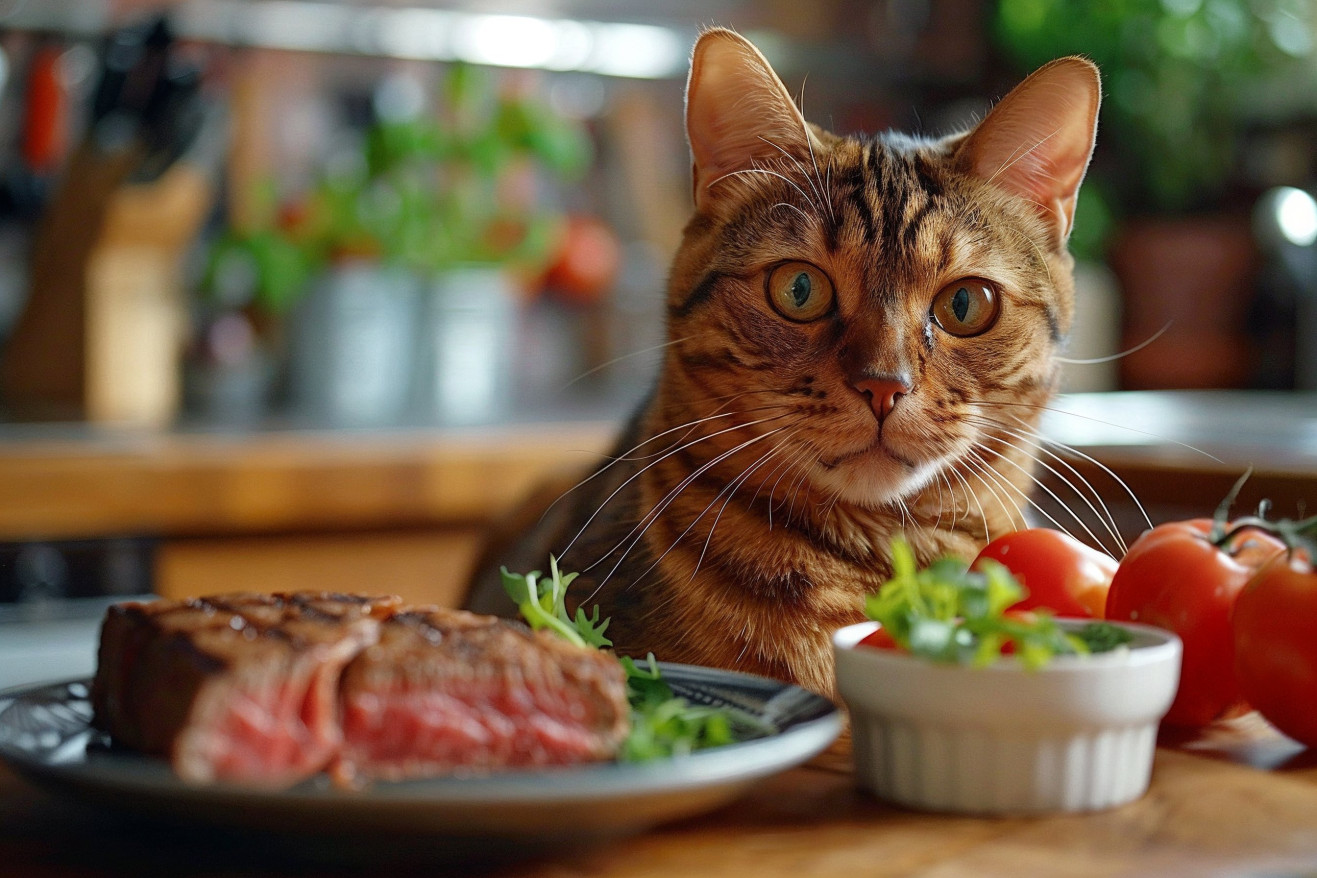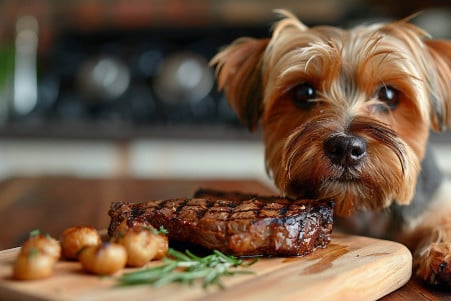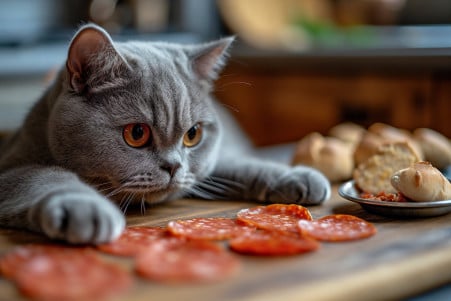Can Cats Eat Steak? A Guide to Safe Feline Treats
25 February 2024 • Updated 24 February 2024

Steak is a delicious treat for people, but can you share this carnivorous delight with your cat? Cats can eat steak as a treat. However, it should be cooked, lean, and free of any seasonings or sauces. It should also be cut into small pieces to avoid choking. That said, steak should not be used as a substitute for a well-balanced, species-appropriate diet for cats.
Drawing on veterinary science and animal nutrition, and referencing scholarly research and expert opinions, this article will take a deep dive into what cats need in their diet. This piece will examine the nutritional value and potential concerns of giving cats steak, including how much to give them, how to prepare it, and why it’s important to make sure they’re getting a well-rounded diet.
By the end of this article, you’ll know exactly how to treat your cat without putting their health at risk.
Can cats eat steak?
Nutritional Needs for a Healthy Cat
Cats are obligate carnivores, so their nutritional needs are centered around protein, with certain amino acids forming the foundation of their diet. Taurine and arginine are two amino acids that are critical to a cat’s health, helping to support their eyes and heart and prevent life-threatening diseases.
A taurine deficiency can lead to blindness and heart disease in cats, while a lack of arginine can cause a dangerous increase in blood ammonia levels, according to PetMD.
The Association of American Feed Control Officials (AAFCO) requires that adult cat food contain a minimum of 6.5 grams of protein per 100 kilocalories to ensure that a diet meets the basic needs of cats. Steak, which is high in protein, can help meet this requirement by providing the amino acids cats need to stay healthy.
That said, while steak can be a good source of protein, it doesn’t contain all of the nutrients cats need. The Clinical Nutrition Service at Cummings School notes that this is especially important to keep in mind if you have an older cat or a cat with a medical condition that requires a special diet.
That said, steak can be a good addition to a cat’s diet when it’s part of a balanced meal plan. It can help meet a cat’s carnivorous nutritional needs without sacrificing the other nutrients they need to stay healthy.
Nutritional Value of Steak for Cats
Steak is an excellent source of protein, providing all nine essential amino acids that cats need. A study published in the Journal of Animal Science found that beef is a rich source of proteinogenic amino acids, which are important for maintaining muscle mass and overall health in cats.
In addition, Healthline notes that steak is high in a number of vitamins and minerals, including vitamin B12, zinc, selenium, iron, niacin, and vitamin B6, all of which are important for cats.
That said, the fat content of steak, especially saturated fat, is something to be aware of when it comes to cats. While some fat is important for energy, too much can lead to obesity and other health problems in cats.
While researchers have found that CLA, a type of fat found in steak, has been linked to a number of health benefits in people, the same can’t be said for cats, and more research is needed.
The risk of bacterial contamination in steak can also be a concern for cats. Raw or undercooked steak can be a source of dangerous bacteria, so it’s important to make sure that it’s cooked thoroughly.
If precautions are taken, such as focusing on leaner cuts and making sure that it’s cooked thoroughly to avoid bacterial contamination, steak can meet a cat’s nutritional needs and be a healthy addition to their diet.
This is especially true if you make sure to take these precautions, as it will ensure that the nutritional benefits of steak can be enjoyed by your cat without any of the potential risks.
Portion Control: How Much and How to Prepare Steak for Cats
As with any treat, it’s important to practice portion control when feeding your cat steak. The American Society for the Prevention of Cruelty to Animals (ASPCA) recommends that treats, including steak, should make up no more than 10% of your cat’s daily caloric intake. A portion of steak for a cat should be a few small pieces of cooked steak, which is about one to two teaspoons for an average-sized cat.
There are also specific safety concerns to keep in mind when cooking steak for your cat. Veterinarians advise that the steak be cooked to a safe temperature to kill bacteria that can cause foodborne illness. According to research from the Centers for Disease Control and Prevention, this can be achieved by cooking the steak to an internal temperature of 145F (63C) and letting it rest for three minutes.
When you first introduce steak to your cat, start with a small portion to see how your cat tolerates it and to avoid stomach upset. Also, make sure to remove any bones and cut the steak into small pieces to prevent choking.
While steak can be a fun and tasty addition to your cat’s diet, it’s important to remember that it’s a treat and not a dietary staple. Your cat’s primary food should be a nutritionally complete and balanced cat food, with steak being an occasional indulgence.
Potential Risks of Feeding Cats Steak
While feeding cats steak can be a great way to give them a protein-rich treat, it’s important to consider the potential risks. Choking is a concern that can be avoided by cutting the steak into small, bite-sized pieces.
The Merck Veterinary Manual lists a number of gastrointestinal issues, including vomiting, diarrhea, and constipation, that could be indicative of gastrointestinal problems. These can be avoided by introducing steak into a cat’s diet slowly and watching for any adverse reactions.
Cats’ anatomy and physiology make them well-suited to a high-protein diet, as shown in a study in PMC, which found that cats have a higher protein digestibility than dogs. However, a high-protein diet, while it has many benefits, can also lead to an excess of certain nutrients, which can lead to kidney issues and other health problems if not managed properly.
Veterinarians stress the importance of balance and moderation when feeding cats high-protein foods like steak. By being aware of these risks and making sure to feed steak in moderation, as part of a diet that includes all the nutrients cats need, cat owners can help ensure their pets stay healthy in the long run.
Feeding Cats Steak: Nutritional Needs and Supplementation
It’s important to know the nutritional needs of cats, especially when it comes to essential nutrients like taurine and iron.
Cats need taurine, an amino acid found in animal protein, to support their vision, digestion, and heart health. Cats can’t make taurine on their own, so they need to get it from their diet, and raw meats like steak are a good source. However, a deficiency can result in serious health problems like blindness and heart disease.
Iron is also important; as the Falls Road Animal Hospital notes, iron is needed to make red blood cells, which can help prevent anemia.
While steak can help with these nutritional needs, it’s important to make sure you’re not causing an imbalance. Too much iron can lead to iron toxicity, and while taurine is generally non-toxic, it may not be necessary to add it as a supplement if your cat is already getting enough from its diet.
As VCA Animal Hospitals points out, a diet that includes high-quality animal protein should provide enough taurine to meet a cat’s needs, so you shouldn’t have to supplement it.
To make sure your cat’s diet is balanced when you’re feeding them steak, you’ll want to make sure you know the nutritional content of the other foods you’re feeding them and supplement as necessary. Always talk to your vet before you add supplements to your cat’s diet, as they can let you know if your cat’s diet is meeting its nutritional needs and whether supplementation is necessary.
So, Can Cats Eat Steak?
Our exploration into the world of feline cuisine has revealed that steak can be a safe and enjoyable treat for cats, as long as it’s consumed in moderation and prepared properly. To avoid potential health hazards like choking and bacterial infections, steak should be well-cooked, lean, and free of spices.
While the protein in steak can help fulfill a cat’s dietary requirements, it should never be used as a substitute for a well-rounded diet that meets a cat’s nutritional needs.
As always, if you’re considering making any major changes to your cat’s diet, be sure to talk to your vet first. A vet can offer personalized recommendations based on your cat’s individual needs, including their age, health, and nutritional requirements. A vet’s guidance will help ensure that treats like steak are used to supplement your cat’s diet and support their overall health and well-being.
In the end, while steak can be an occasional and enjoyable treat for cats, it’s the thoughtful consideration and balance in a cat’s diet that will help ensure the health and happiness of our furry friends.


